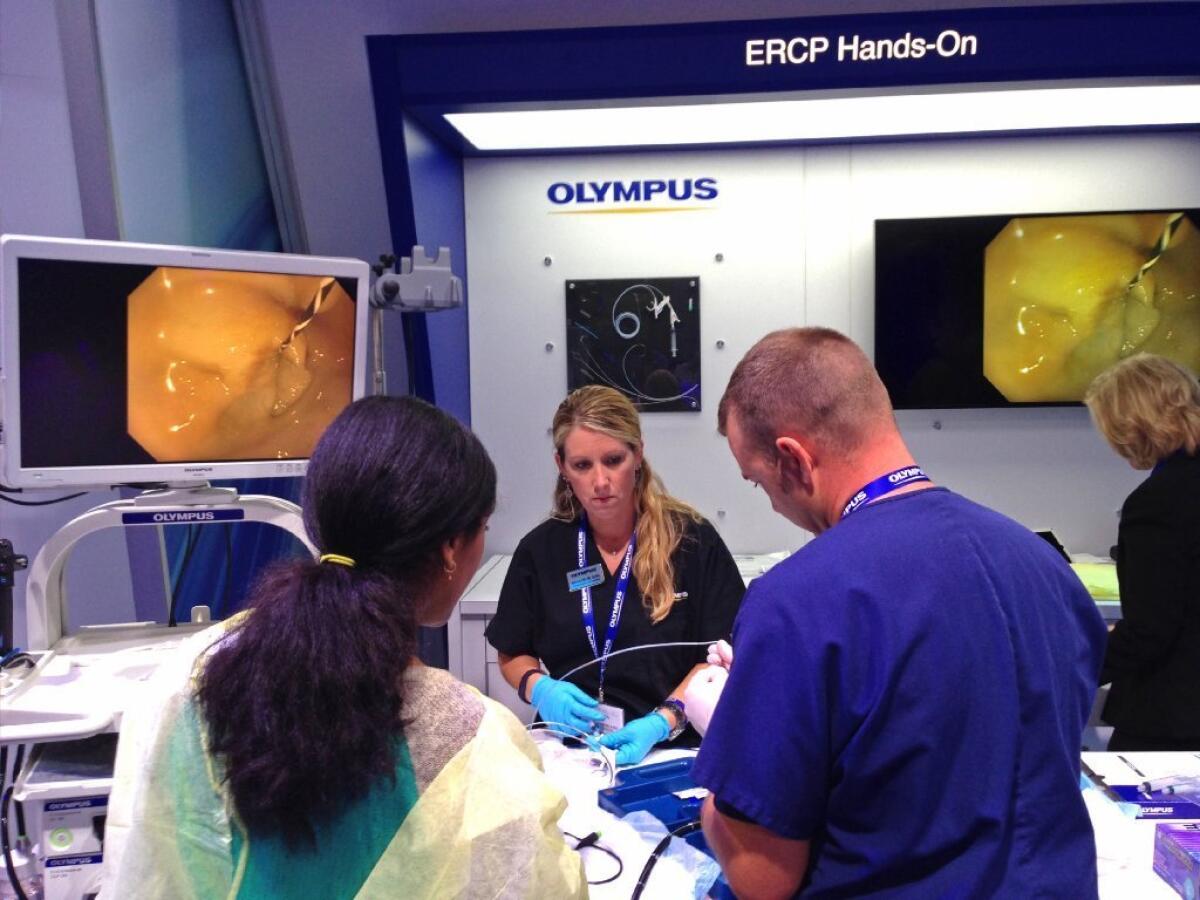Another outbreak from tainted scopes suspected at an L.A.-area hospital

Huntington Memorial Hospital in Pasadena has notified patients who may have been infected by a contaminated medical scope made by Olympus Corp. Above, Olympus showcases its ERCP scopes at a Washington medical conference in May.
A Pasadena hospital is investigating a suspected outbreak related to the same type of medical scope tied to superbug infections across the country.
Huntington Memorial Hospital said Wednesday it had alerted health authorities about a potential link between patients who have a pseudomonas bacteria and the Olympus Corp. duodenoscopes used to treat them.
Many forms of deadly bacteria can become trapped inside the reusable devices and get passed on to future patients. Federal regulators have attributed this to a design flaw that makes the tip of these instruments hard to clean even when following the manufacturers’ guidelines.
Huntington Memorial said it discovered the potential problem in June during a review of lab samples, and it has reported three patient infections to health officials so far. That number could grow as more medical detective work is done.
“We are still investigating the potential link and have engaged two nationally renowned medical research facilities for assistance,” said Dr. Paula Verrette, senior vice president and chief medical officer for quality and physician services at Huntington Memorial.
“Even though the link between the scope and bacteria is not confirmed, we alerted the affected patients about a possible link as well as reported the bacterial growth to health officials,” Verrette said.
Huntington confirmed its investigation in response to questions from The Times. The hospital declined to provide further details on the three cases or the number of patients exposed to these scopes, citing medical privacy laws.
The potential outbreak underscores the ongoing difficulty that hospitals nationwide have in cleaning and inspecting these scopes — despite intense scrutiny on these devices and the threat they may pose to patients.
The widening problem is sure to ratchet up pressure on the Food and Drug Administration and scope makers to better address concerns about patient safety. Both regulators and the companies have been under fire for ignoring earlier warnings on the infection risk.
Despite all this, federal officials have insisted that the troublesome scopes remain on the market, because there’s no better alternative and many critically ill patients benefit from their use.
But some medical experts said these incidents remain underreported and the number of scope-related infections may be far higher.
“This may be a more common occurrence that’s been going on for years with these scopes,” said Dr. James McKinnell, an expert on hospital epidemiology at the L.A. Biomedical Research Institute at Harbor-UCLA Medical Center. “It’s sort of opening up Pandora’s box as we dig in.”
Monday, FDA officials issued warning letters to Olympus and two other scope makers, Fujifilm and Pentax Medical, for a range of safety-related violations. Olympus was cited for not reporting infections to authorities in a timely manner.
The U.S. Justice Department is also investigating the superbug outbreaks and has sent subpoenas to all three scope manufacturers.
The pseudomonas uncovered at the Pasadena hospital is a common cause of infections, but some strains of the bacteria are resistant to all antibiotics. That can make it deadly for some patients.
The bacteria are similar to the CRE superbug at the center of the outbreak at UCLA’s Ronald Reagan Medical Center that sickened eight patients, including three who died.
The UCLA outbreak was first reported by The Times in February. A month later, Cedars-Sinai Medical Center in Los Angeles said it had discovered four patients infected from tainted Olympus scopes.
Health officials have urged all hospitals to review their medical records to look for possible infections that have gone undetected.
In these cases, the bacteria can be transmitted during a procedure known as endoscopic retrograde cholangiopancreatography, or ERCP.
Nationally, more than 650,000 ERCP procedures are performed each year, in which a fiber-optic scope is threaded down the person’s throat to diagnose and treat problems in the digestive tract such as gallstones, cancers and blockages in the bile duct.
These instruments are not the same type used in more routine endoscopies and colonoscopies.
Olympus holds an 85% share of the U.S. market for duodenoscopes and other specialty endoscopes. A company spokesman didn’t have an immediate comment on the incident in Pasadena.
In previous statements, the device maker has stressed that multiple factors can contribute to patient infections besides a flawed scope design, such as human errors during cleaning.
The Pasadena hospital said it has adopted safety measures such as quarantining disinfected scopes for 48 hours before reuse to check for any bacterial growth. The hospital didn’t make it immediately clear when that step was added.
Other hospitals with outbreaks, such as Virginia Mason Medical Center in Seattle, are using that method to help protect patients.
Huntington Memorial said it explained the risk of the ERCP procedure to patients and their families. “This is a problem facing every hospital,” Verrette said. “We cannot deprive appropriate care to patients whose health issues can be relieved or addressed through the use of these scopes, but we are proceeding with an abundance of caution in our disinfecting and monitoring protocols to ensure patient safety.”
A spokesman for the Pasadena Public Health Department, which was contacted by the hospital, said it was aware of the situation and had asked for help from L.A. County authorities.
In response to the recent outbreaks, the U.S. Department of Veterans Affairs examined records to determine whether scopes sickened any of its patients. Doctors at the VA found that almost 100 patients treated with the same type of medical scope linked to the deaths of three patients at UCLA tested positive for a superbug known as CRE, or carbapenem-resistant enterobacteriaceae.
But in all but a dozen cases, the VA researchers ruled out the possibility that the patients’ infections came from a possibly tainted scope, according to the study published last week.
VA officials said there didn’t appear to be a wide-scale problem at its centers.
Twitter: @chadterhune
Times staff writer Melody Petersen contributed to this report.
ALSO:
Massive Rocky fire was sparked by faulty water heater, investigators say
Former L.A. County sheriff’s captain pleads guilty in jail scandal
Steve Lopez: Pizza maker burns time and dough on red tape
More to Read
Inside the business of entertainment
The Wide Shot brings you news, analysis and insights on everything from streaming wars to production — and what it all means for the future.
You may occasionally receive promotional content from the Los Angeles Times.











